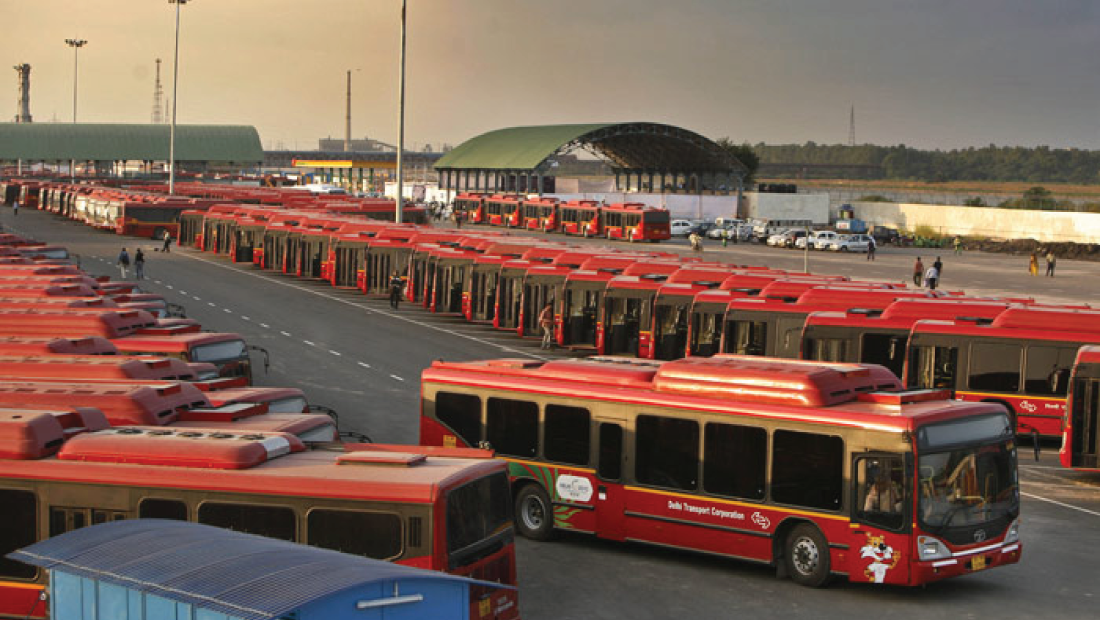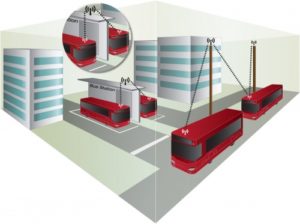
23 Mar 2015 Fluidmesh Data Offload Solution
A Fluidmesh offload solution system is designed to create high-speed, reliable wireless network connections to multiple vehicles in a transportation yard. The system is used to transfer large amounts of recorded video and metadata from vehicles such as trains or buses in depot yards to the storage locations residing on the corporate network. A Fluidmesh offload system can support transfer per vehicle of up to 100 Mbps and can prioritize certain vehicles over others, if necessary.
With multiple wireless base stations installed in a yard, aggregate throughput of the entire system can be as high as 2 Gbps, depending on available spectrum at the deployment location.
 The Fluidmesh system includes an intelligent load-balancing algorithm to assign the wireless client in each vehicle to an available base station based on load and demand. All wireless connections are built with Prodigy 2.0, the Fluidmesh intelligent transmission protocol built on MPLS. This protocol ensures fast association time of client and base station, and a seamless fast handoff between base stations during load balancing decisions. Prodigy 2.0 also manages the wireless connections to confirm the RF encoding and network transmission parameters are always in sync, ensuring a high-speed, low jitter wireless network.
The Fluidmesh system includes an intelligent load-balancing algorithm to assign the wireless client in each vehicle to an available base station based on load and demand. All wireless connections are built with Prodigy 2.0, the Fluidmesh intelligent transmission protocol built on MPLS. This protocol ensures fast association time of client and base station, and a seamless fast handoff between base stations during load balancing decisions. Prodigy 2.0 also manages the wireless connections to confirm the RF encoding and network transmission parameters are always in sync, ensuring a high-speed, low jitter wireless network.
Prodigy 2.0 is a lightweight protocol that allows more guaranteed high-quality airtime for data transfer rather than network management, retransmissions or error corrections. Prodigy 2.0 does not allow a weak client connection to slow down the wireless network, as in 802.11, but instead can gives each client device a dedicated time to speak.
The Fluidmesh system is built from three components: an on-board radio, an onboard antenna, and a set of base stations in the yard. The radio is typically installed in an easily serviceable indoor location on the Railcar, but is fully hardened for outdoor deployment if necessary. A radio equipped with the depot vehicle firmware can support up to 100mbps in one direction, and up to 180mbph aggregate throughput.
The onboard antenna can be one of several types, including direction panel antennas, omnidirectional antennas, or low profile “shark-fin” antennas. Each has its advantages, and special attention needs to be given in choosing the correct antennas for the deployments.
The base stations in the yards are typically chosen from the 3200 line of Fluidmesh equipment. Typically, because the fm3200-hw includes an integrated 120 degree sector antenna, it is chosen for yard deployments. However, in a linear yard, the fm1200 Volo may be a better choice as it embeds a 33 degree patch antenna.
Each base station is capable of supporting up to 100Mbps when enabled with the correct licenses. To extend coverage throughput in a yard on a single frequency, multiple base stations can be deployed in the appropriate locations. To increase the aggregate throughput of the entire train-protect yard solution, base stations set to non-overlapping carrier frequencies can be deployed over the same airspace. When the system is deployed, each base station is installed on the same subnet or Vlan; discrete subnets are tunneled together with a built-in L2TP feature.
All base stations update each other through the backbone network, keeping management chatter off of the wireless vehicle network. Every base station is given a list of all depot vehicle radios that are allowed to operate in a given yard.
The depot vehicles are set to a default frequency. Typically, the default frequencies are evenly distributed among the depot vehicles. When a new depot vehicle radio enters the yard, it communicates on its default frequency with the base station(s) it can see. That base station(s) determines if that depot vehicle should continue communication on the same channel, or switch to a less loaded set of base stations. The base stations monitor all the available points of access, and periodically adjust which depot vehicles communicate with which set of base stations. Switching between base stations in the same frequency is accomplished in several milliseconds. Switching between base stations in different frequencies is accomplished in several dozen milliseconds. Because of the label switched (MPLS) network environment, the handoff of depot vehicles among the many base stations does not require any reconfiguration of the TCP/IP addressing from edge to edge in the network.
Each depot vehicle maintains the exact same IP address and available port information as if it were always wired into the same physical switch port in the upland network. This critical advantage that Fluidmesh offers allows the high throughput video and storage management processes to continue completely uninterrupted.
To correctly design the Fluidmesh network, one must consider the number of depot vehicles that will be in a yard, the amount of data that must be transmitted, and the amount of time available for the transfer. For some yards, a further consideration is the physical layout; if there are significant wireless obstructions, more than one base station per frequency needs to be carefully placed and installed.
Consider, for example, a fleet of 25 trains that each store 15GB of data per day. That amounts to 375GB per day that needs to be transferred in the yard. If the network will be available for three hours each evening, then the wireless network needs to transfer 1000Gb/hour, which works out to an aggregate speed of 277Mbps over those three hours. If each channel can handle 100Mbps, then a minimum of three channels are needed in the yard. If we make a simplifying assumption that all 25 vehicles can keep a strong connection to one physical mounting location in a yard (i.e., the reach of each channel does not need to be extended), then three FM3200 base stations should be sufficient to deliver high-speed, reliable wireless network connections to all the vehicles in the transportation yard.